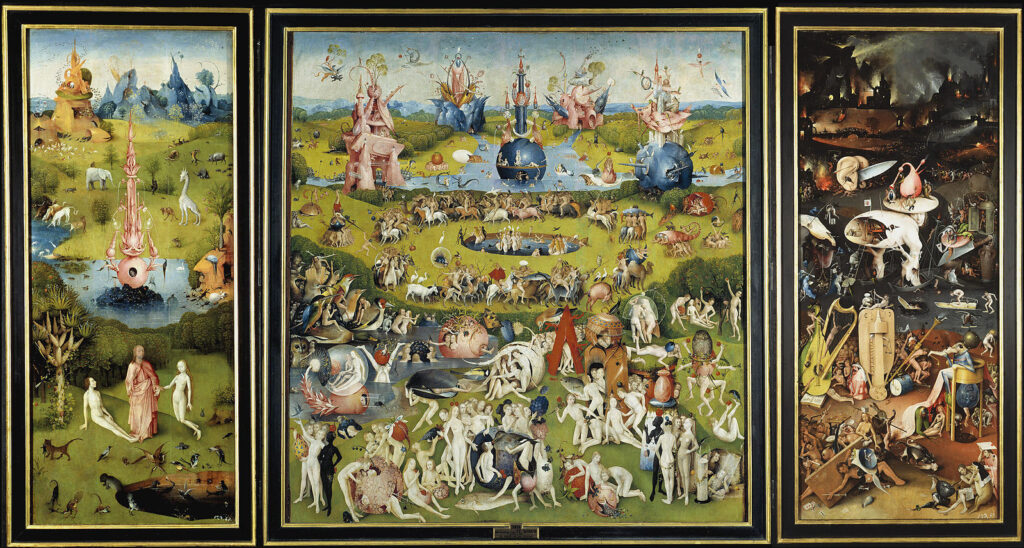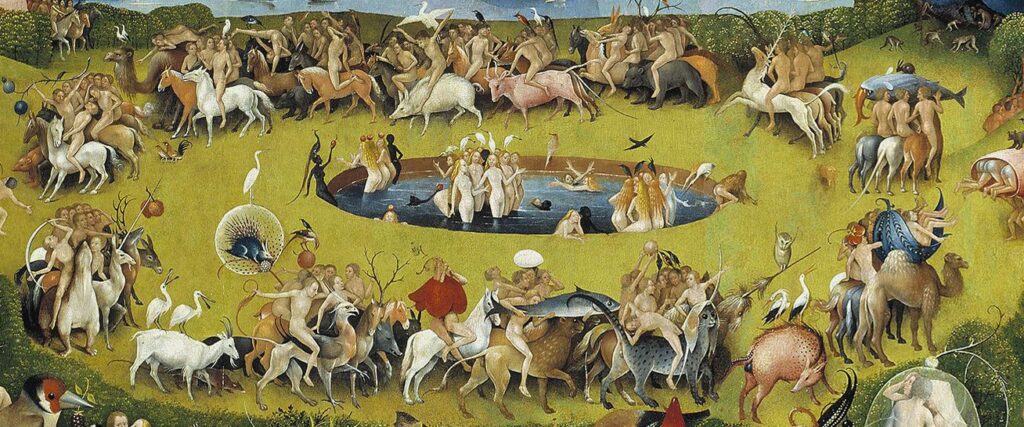From the cover of a Travis Scott album to a pair of limited edition Dr. Martens, early Netherlandish painter Hieronymus Bosch has inspired modern artwork in profound ways.
Little is known about the Dutch painter, despite his work’s impact on art throughout the centuries. One of his most well-known, evocative paintings is undoubtedly The Garden of Earthly Delights.
Using surreal and often nightmarish imagery, Bosch’s work is so complex that it would take years to truly understand it.
Painted as three panels, this triptych has a lot of history and theories attached to it. Here, we will look into 15 facts about The Garden of Earthly Delights, picking apart some of the conspiracies and stranger parts of the painting.

What are the Three Parts of The Garden of Earthly Delights?
In this article, we will be referring to the three panels of The Garden of Earthly Delights, as well as the painted exterior.
To recognize just how interesting these facts are, it’s important to know the difference between the three parts of the painting.
- Exterior: The exterior of The Garden of Earthly Delights, unlike the inside, is painted as one piece. It depicts a closed garden, believed to be the creation of the world or the Garden of Eden. Unlike the strange inner panels, the exterior painting is serene and idyllic.
- Left Panel: The first part of the triptych’s story is on the left panel, sometimes known as Joining of Adam and Eve, shows just that. A figure believed to be God holds the wrist of Eve while Adam sits on the ground on the other side of him. Animals of all sorts surround them, but the scene dips into the surreal behind the trio.
- Center Panel: The most intricate panel is the center, showing even more surreal subjects and fantastical creatures. This panel depicts humanity engaged in its many indulgences.
- Right Panel: The final panel shows the consequences of the indulgences and sins of the previous center panel. Bosch painted a hellscape full of grotesque imagery and bizarre scenes.

What Does The Garden of Earthly Delights Symbolize?
Considering how complex and detailed The Garden of Earthly Delights is, many are overwhelmed upon seeing it and don’t fully comprehend the symbology behind the triptych.
In short, The Garden of Earthly Delights symbolizes humanity’s fall from grace, moving from innocence to sin and finally the consequences of those sins.
15 Facts About The Garden of Earthly Delights
- The Garden of Earthly Delights is painted in a series of three panels that are connected, telling a story from left to right. Triptychs aren’t meant to be separated and should be displayed together.
Unique to The Garden of Earthly Delights is the exterior, which is painted just as intricately as the three inner panels.
- Little is Known About Hieronymus Bosch
Many famous painters made the meanings behind their paintings very clear, usually through writings that have survived. On the other hand, Hieronymus Bosch is somewhat of an unknown.
Bosch is a mystery–we know that he lived from 1450-1516, that his grandfather was also a painter, and he was born with the name Jheronimus van Aken, which he changed to distinguish himself among a family of painters.
- Parts of The Garden of Earthly Delights Were Taken From Bosch’s Earlier Works
While a great deal of The Garden of Earthly Delights was original ideas painted specifically for this triptych, some of the subjects were ones that Bosch had painted before.
For example, his pen drawing Man, Tree, depicts one of the most memorable parts of The Garden of Earthly Delights, the tree man with the hollow torso which contains a scene all its own inside.

- We Have No Idea When the Bosch Painted The Garden of Earthly Delights
A huge frustration for art historians is the fact that Bosch didn’t date his paintings. The painter is so mysterious that we don’t have a date for when any of his works were completed, this one included.
Oddly enough, he did sign a few of them, something that wasn’t common for artists of that day. All in all, around 25 of Bosch’s paintings survived to the modern day, all of them dateless.
- The Garden of Earthly Delights is Enormous
A lot of paintings that are famous in the public sphere, like the Mona Lisa, are surprisingly small. On the other hand, it’s difficult to understand the size of The Garden of Earthly Delights without seeing it in person–it’s huge!
The size of The Garden of Earthly Delights is as follows:
- 220 x 389 cm (87 x 153 inches), or 2.21 x 3.89 m (7.25 x 12.25 feet)
- What’s the Deal With the Strawberries?
In modern times, the fruit that we consider linked most with temptation and the Fall of Man is the pomegranate. Back in Hieronymus Bosch’s day, though, the strawberry was considered the most sinful fruit.
This is why so many strawberries are featured in the center, indulgence-focused second panel of the triptych. Here the strawberries are meant to represent temptation and the pleasures of the flesh.
- Hieronymus Bosch Likely Never Saw Some of the Animals He Painted
During the time that Hieronymus Bosch was painting The Garden of Earthly Delights, many adventurers were traveling to new parts of the globe and bringing back sketches and drawings of animals that had never been seen in the Netherlands before.
Bosch took inspiration from these drawings, just like many other artists of the time, and included them in his triptych. This means that, while Bosch likely never saw a giraffe or a lion, he was able to accurately depict them.

- Hieronymus Bosch Completed Two Other Large Triptych Paintings
Of the 25 paintings by Hieronymus Bosch that have survived to the modern day, three of them are in the same massive triptych style as The Garden of Earthly Delights.
The other two triptych paintings that he completed were The Last Judgment, which depicts Eden, the Last Judgment, and Hell, and The Haywain Triptych, which depicts similar scenes to The Garden of Earthly Delights but focuses on several sins and not just lust.
- Each Part of The Garden of Earthly Delights Has its Own Name
All three panels of the triptych are made to be displayed and viewed as one single piece. Together, they are called The Garden of Earthly Delights, but each panel also has its own name.
- The left panel is known as the Joining of Adam and Eve.
- The center panel is known by the same name as the triptych overall, The Garden of Earthly Delights
- The right panel is known simply as Hell.
- Hieronymous Bosch May Have Included a Self Portrait
The infamous Tree Man, who is the centerpiece of the right hellscape panel, might actually be a self-portrait of Hieronymous Bosch himself.
The cracked-egg body of the Tree Man is at the forefront of the painting, but if you look a little closer, you can see the face of the Tree Man peeking out from behind the strange torso. This face has a remarkable resemblance to the few available portraits of Bosch.
- The First Record of the Painting Came After Hieronymous Bosch’s Death
Since we’ve ascertained that Bosch didn’t date his paintings, it’s impossible for us to know when he painted it. Complicating matters even more is the fact that the first mention of The Garden of Earthly Delights didn’t appear until a year after his death.
This record comes from Antonio de Beatis who described the triptych and wrote that he had seen the painting decorating the home of the Counts of Nassau in Brussels.
- Bosch’s Religion May Have Influenced All the Nude Figures
While there is little known about Bosch’s life outside of his paintings, some experts believe that he might have been a member of a heretical sect known as the Adamites.
The theory was brought to light in 1947 by author Wilhelm Fränger in his book The Millennium of Hieronymous Bosch. The idea of Bosch being an Adamite is important because this sect celebrated sex and nature.
They even performed their rituals in the nude–just like all the figures in The Garden of Earthly Delights.
- The Garden of Earthly Delights Inspired Salvador Dalí
Centuries may have separated Early Netherlandish artist Hieronymous Bosch and famous modern surrealist Salvador Dalí, but one look at their work shows just how much inspiration Salvador Dalí took from Bosch.
Dalí considered Bosch an art-historical mentor, and certain images and themes of Dalí’s work directly reflect parts of The Garden of Earthly Delights.
- The Garden of Earthly Delights Has Carried Many Names
The current name for the triptych might be a mouthful, but it’s also a modern interpretation of the painting’s identity.
At other times in history, the triptych has been called Strawberry Painting, in reference to the abundance of the fruit pictured in the center panel, as well as La Lujuria, which is Spanish for Lust, a fitting name considering the scenes depicted within.
- The “Butt Music” Has Been Transcribed
With such a strange painting being the focus of this list, it’s only fair that our final fact is equally as bizarre.
In the right panel, there are depictions of instruments–thought to symbolize the justice system and its corruption–where a judge is composing music on the bare backside of a sinner.
One Oklahoma Christian University student, Amelia Hamrick, decided to transcribe this so-called butt music, and from there, the song gained notoriety on the internet, as well as several interpretations of the song.
For the brave, the butt music can be found here.
References
“How Hieronymus Bosch’s Hell Lives on Today”-Nathan Dune
“Religion: Bosch and the Flesh”
https://content.time.com/time/subscriber/article/0,33009,816630,00.html
“Hieronymus Bosch Butt Music”